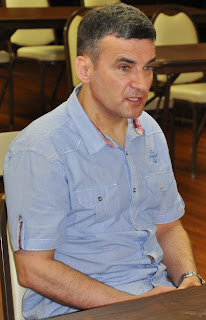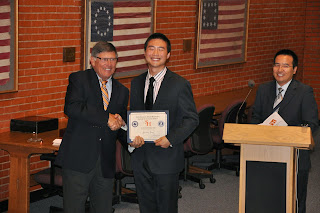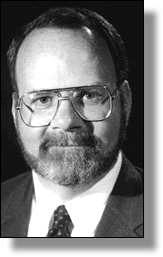
Dr. William King was appointed the IACP's National Law Enforcement Policy Center board.
Dr. William King, Associate Dean of Research and Program Development at the College of Criminal Justice, was recently appointed to the International Association of Chiefs of Police (IACP) National Law Enforcement Policy Center (NLEPC), Advisory Board. The board helps develop model policies and procedures for law enforcement agencies.
“I am honored to serve the IACP and the law enforcement community by serving on the Policy Center’s Advisory Board,” said Dr. King. “This appointment reflects the influence of the College of Criminal Justice in justice issues at the national level, and I am looking forward to contributing to IACP’s mission.”

Dr. William King conducted a study of the NIBIN system for the National Institute of Justice. The College, one of the oldest and largest criminal justice programs in the country, has been at the forefront of research on issues in the field. As Associate Dean, Dr. King oversees projects on such key issues as eyewitness identification, sexual assault investigations, ballistics evidence, gangs, crime victim issues, toxicology and DNA studies, to name a few.
“Dr. King’s contributions to the board are directly aligned with the contributions the College of Criminal Justice at SHSU hopes to make to the field,” said Interim Dean and Director Phillip Lyons. “Good policy and best practice are informed by sound research and Dr. King is very much on top of it.”

Law enforcement officers examine eyewitness identification procedures at a LEMIT training. The College also conducts research for the Bill Blackwood Law Enforcement Management Institute of Texas (LEMIT), a premiere professional development program in management and leadership for law enforcement professionals in Texas.
“Having Dr. Bill King appointed to such an important IACP advisory committee, such as the National Law Enforcement Policy Center (NLEPC), is a testament to his expertise on law enforcement related issues,” said Dr. Rita Watkins, Executive Director of LEMIT. “Dr. King has researched and submitted key results in a manner that is instrumental in helping police agencies in Texas and across this county establish and implement sound policies and procedures. Ongoing research in the law enforcement field helps agencies identify best practices and Bill King is committed to getting timely research out to the field and in the hands of practitioners who face those issues daily.”
 As an arm of the International Association of Chiefs of Police, the 11-member NLEPC board oversees the development and update of model policies for day-to-day operations and administrative procedures in law enforcement agencies. Since 1987, the board has produced more than 125 white papers on key issues in criminal justice, most recently on the use of body worn cameras by police officers.
As an arm of the International Association of Chiefs of Police, the 11-member NLEPC board oversees the development and update of model policies for day-to-day operations and administrative procedures in law enforcement agencies. Since 1987, the board has produced more than 125 white papers on key issues in criminal justice, most recently on the use of body worn cameras by police officers.
“The intent is to put together model policies and procedures to help provide the best practices in administrative and operational areas,” said Philip Lynn, Manager of the NLEPC. “Each one comes with a research paper that reflects legally sound policy and contemporary and best practices, particularly for medium and small-sized cities. These are not standards, but rather recommendations.”
 The board, which includes representatives from police leadership, accrediting agencies and academia from across the country, are expected to examine policy revisions on missing children, patrol dogs, personal appearance and standards of conduct at upcoming sessions. These revisions are generally reviewed if the policies are outdated or if there have been changes to the law.
The board, which includes representatives from police leadership, accrediting agencies and academia from across the country, are expected to examine policy revisions on missing children, patrol dogs, personal appearance and standards of conduct at upcoming sessions. These revisions are generally reviewed if the policies are outdated or if there have been changes to the law.
The model policies are currently contained in seven volumes and cover the gamut of day-to-day operational issues of departments. Among some of the most recent issues discussed are:
- Excited Delirium
- Recording Police Activities
- Interviewing and Interrogating Juveniles
- Critical Incident Stress Management
- Special Weapons and Tactics
- Retaliatory Conduct by Employees
- Missing Persons with Alzheimer’s
- Social Media
- License Plate Readers
- Stalking/
- Pregnancy
- Personal Relationships in the Workplace













 Dean Friel established many scholarships and endowments.
Dean Friel established many scholarships and endowments.


 Dr. Zhang is a faculty member at Guangxi University in China.
Dr. Zhang is a faculty member at Guangxi University in China. Elliot Fana, a graduate of the master's in forensic science program, works in Botswana fighting hoof and mouth disease.
Elliot Fana, a graduate of the master's in forensic science program, works in Botswana fighting hoof and mouth disease.



 “The public has been led to believe that gang members are black and Latino males and that once someone joins a gang they cannot leave a gang, both of which are patently false,” said David Pyrooz, assistant professor of Criminal Justice at Sam Houston State University.
“The public has been led to believe that gang members are black and Latino males and that once someone joins a gang they cannot leave a gang, both of which are patently false,” said David Pyrooz, assistant professor of Criminal Justice at Sam Houston State University.  The study also found that gangs have high turnover rates of 36 percent, with about 400,000 youth joining gangs, and another 400,000 youth leaving gangs, every year. This means that gangs have to constantly recruit new talent to their groups, not unlike service-industry or other occupations where employees frequently quit after a short period.
The study also found that gangs have high turnover rates of 36 percent, with about 400,000 youth joining gangs, and another 400,000 youth leaving gangs, every year. This means that gangs have to constantly recruit new talent to their groups, not unlike service-industry or other occupations where employees frequently quit after a short period. 
 “Rich and poor, black and white, male and female, and one and two-parent households -- what matters is that law enforcement and healthcare clinicians avoid the stereotypes of these kids when working with this population.” said Sweeten
“Rich and poor, black and white, male and female, and one and two-parent households -- what matters is that law enforcement and healthcare clinicians avoid the stereotypes of these kids when working with this population.” said Sweeten


 “You can clearly see that after death, there is still order,” said Joan Bytheway, director of STAFS and specialist in forensic anthropology. “It doesn’t go chaotic after death. There is still order in the process. That’s pretty amazing, really.”
“You can clearly see that after death, there is still order,” said Joan Bytheway, director of STAFS and specialist in forensic anthropology. “It doesn’t go chaotic after death. There is still order in the process. That’s pretty amazing, really.” “Even from the initial conception of STAFS, I wanted it to be interdisciplinary,” said Bytheway. “We didn’t have an anthropology department, so I needed forensic science to include some other people. We get donations that are so valuable, families give us their loved ones, and we want to use these bodies to get as much information as possible from them. You can see when we’re done, all we have left is the skeleton which we also keep for our records.”
“Even from the initial conception of STAFS, I wanted it to be interdisciplinary,” said Bytheway. “We didn’t have an anthropology department, so I needed forensic science to include some other people. We get donations that are so valuable, families give us their loved ones, and we want to use these bodies to get as much information as possible from them. You can see when we’re done, all we have left is the skeleton which we also keep for our records.”  The learning opportunities at STAFS are abundant for seasoned researchers as well as students. Bytheway estimates that about 75 percent of the students working at STAFS are undergraduates. The research that students participate in helps their futures, and due to the sheer volume of the projects at STAFS their help is also crucial to keep the facility running at its current pace.
The learning opportunities at STAFS are abundant for seasoned researchers as well as students. Bytheway estimates that about 75 percent of the students working at STAFS are undergraduates. The research that students participate in helps their futures, and due to the sheer volume of the projects at STAFS their help is also crucial to keep the facility running at its current pace. “The CDI is formed when the fluids from a decomposing body leach out into the soil and kill the surrounding vegetation leaving a dark area basically outlining the body,” said Tanner. “We’ll look for regrowth of vegetation in these areas so that one day law enforcement might use this information to create a timeline of how long remains have been in a certain area depending on regrowth or lack thereof.”
“The CDI is formed when the fluids from a decomposing body leach out into the soil and kill the surrounding vegetation leaving a dark area basically outlining the body,” said Tanner. “We’ll look for regrowth of vegetation in these areas so that one day law enforcement might use this information to create a timeline of how long remains have been in a certain area depending on regrowth or lack thereof.”






 “Similarly, if we’re running the police information system with permissions, we have data readily available for analysis purposes. Students can use this data to write dissertations and complete independent studies, which is not only beneficial to them, but also the field at large.”
“Similarly, if we’re running the police information system with permissions, we have data readily available for analysis purposes. Students can use this data to write dissertations and complete independent studies, which is not only beneficial to them, but also the field at large.” A major challenge the PRC faces is keeping the database compatible with ever-changing technology.
A major challenge the PRC faces is keeping the database compatible with ever-changing technology. “Agencies are interested in deploying iPads. If an officer is called to a scene and is interviewing a victim or witness, it’s much more convenient to take statements on an iPad than it is on a cumbersome laptop. An iPad can even be carried by motorcycle officers on traffic patrol where a laptop cannot.”
“Agencies are interested in deploying iPads. If an officer is called to a scene and is interviewing a victim or witness, it’s much more convenient to take statements on an iPad than it is on a cumbersome laptop. An iPad can even be carried by motorcycle officers on traffic patrol where a laptop cannot.” “What agencies have not shared, up until recently, are crime reports. If there is a series of burglaries in one jurisdiction, surrounding areas might not know about it. After 9/11 the FBI launched the National Law Enforcement Data Index. We have been a strong supporter of that system. By working closely with the Department of Public Safety, we can enable regional data sharing. All agencies that participate in CRIMES are provided with a consolidated database. They can search their immediate area, their region, or the whole state for any reason necessary.”
“What agencies have not shared, up until recently, are crime reports. If there is a series of burglaries in one jurisdiction, surrounding areas might not know about it. After 9/11 the FBI launched the National Law Enforcement Data Index. We have been a strong supporter of that system. By working closely with the Department of Public Safety, we can enable regional data sharing. All agencies that participate in CRIMES are provided with a consolidated database. They can search their immediate area, their region, or the whole state for any reason necessary.”

 Dr. David Bayley
Dr. David Bayley

 Dr Webb helped create the CJ Career Fair.
Dr Webb helped create the CJ Career Fair. Dr. Webb congratulates students from ZPC.
Dr. Webb congratulates students from ZPC.
 During his tenure, Dr. Flanagan oversaw an increase in enrollment in the College by 20 percent. As a result, the College began offering a satellite program at the University Center in The Woodlands, a collaborative effort among six higher education institutions in the state. Due to the success of that program, Sam Houston State University opened Sam Houston State University -- The Woodlands Center in 2012 to offer a full array of academic courses for undergraduate and graduate students.
During his tenure, Dr. Flanagan oversaw an increase in enrollment in the College by 20 percent. As a result, the College began offering a satellite program at the University Center in The Woodlands, a collaborative effort among six higher education institutions in the state. Due to the success of that program, Sam Houston State University opened Sam Houston State University -- The Woodlands Center in 2012 to offer a full array of academic courses for undergraduate and graduate students.
 Among these were research projects at LEMIT, a film to prevent suicides in jails, National Institute of Justice grants to study citizen complaints against law enforcement and changes in homicide rates in Houston, and an Environmental Protection Agency grant to reduce the extent of environmental crime in the state.
Among these were research projects at LEMIT, a film to prevent suicides in jails, National Institute of Justice grants to study citizen complaints against law enforcement and changes in homicide rates in Houston, and an Environmental Protection Agency grant to reduce the extent of environmental crime in the state.

